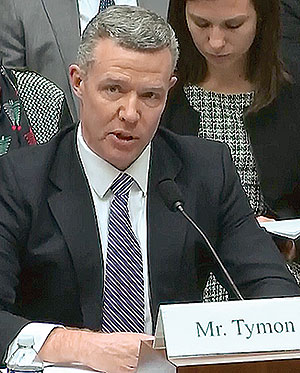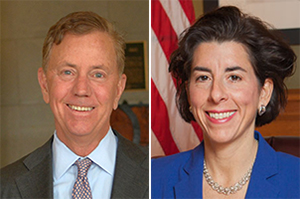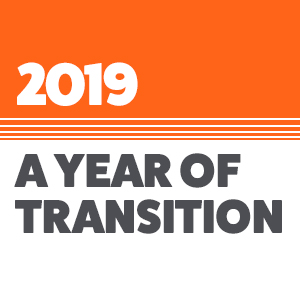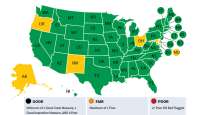Senior Reporter
2019: Hours-of-Service Rule, ELDs and Roads Dominated Political, Regulatory Concerns

[Stay on top of transportation news: Get TTNews in your inbox.]
For the trucking industry, 2019 was a year of transition, replete with regulatory victories and disappointments.
Federal regulators proposed adding flexibility to the hours-of-service rule, while a two-year exemption for grandfathered electronic logging devices expired and roadside inspectors began full enforcement of the Federal Motor Carrier Safety Administration's ELD mandate.
By law, drivers had until Dec. 16 to migrate to ELDs from the legacy AOBRDs (unless operating under a shorthaul rule exemption) or face an out-of-service violation after the deadline.
Business: Freight Market Slowdown, Tariffs Diminished Trucking Industry's Performance
Government: Hours-of-Service Rule, ELDs and Roads Dominated Political, Regulatory Concerns
Timeline: Trucking's biggest moments
Top 10 stories: A mixed bag of industry news
Charts: Truck sales, trailer orders, tonnage figures
Decade in Review: Looking back at front pages since 2010
Commercial vehicle inspectors refused to offer a “soft enforcement” grace period for truck drivers who have not yet made the switch.
Meanwhile, the FMCSA’s proposed HOS rule revision, made public on Aug. 14, might be remembered as one of the industry’s — and the agency’s — crowning achievements of 2019. The proposal would allow truck drivers more flexibility with their 30-minute rest break and with dividing their time in the sleeper berth. It also would stretch by two hours the duty time for drivers encountering adverse weather, and extend the shorthaul exemption by lengthening the drivers’ maximum on-duty period from 12 hours to 14 hours and increasing the distance limit from 100 air miles to 150 air miles.
“It certainly was a year of FMCSA responding to calls from industry to increase flexibility with hours of service,” said Dan Horvath, director of safety policy for American Trucking Associations. And that includes ensuring safe drivers are on the road. In the past few months, regulators have been encouraging drivers and motor carriers to get informed about, and register in, a federal Drug and Alcohol Clearinghouse, which is a database of drivers who fail or cheat on their drug tests.

Horvath
“The work that the agency put in on the Drug and Alcohol Clearinghouse — the education, the webinars, getting out in public and talking about the rule took a lot of effort on their part,” Horvath said of the agency.
Although the database goes live on Jan. 6, FMCSA issued a final rule in early December extending by three years the date for state driver’s licensing agencies to comply fully with certain clearinghouse requirements.
“The compliance date extension allows FMCSA the time needed to complete its work on a forthcoming rulemaking to address the states’ use of driver-specific information from the clearinghouse, and time to develop the information technology platform through which states will electronically request and receive clearinghouse information,” FMCSA said.
The agency said the delay will not impact highway safety.
The clearinghouse is a “step in the right direction for increasing safety and making sure that drivers who have an alcohol or drug violation are getting the necessary treatment,” said Abigail Potter, ATA’s manager of safety and occupational health policy.
Despite these advancements, there also was disappointment this year as — once again — hopes for a significant federal funding bill to improve and maintain the nation’s decaying infrastructure fell victim to partisan disputes.
At the start of the 116th Congress, President Donald Trump and congressional leaders had expressed interest in working together on a comprehensive infrastructure package. For years, myriad stakeholders called on Congress and the president to set aside differences and compromise on legislation that would modernize freight and commuter systems. Amid oversight hearings in the House, it actually appeared possible for such a grand piece of legislation to get done in 2019. By spring Trump and top Democrats had begun to negotiate, but in May that all collapsed at the White House with each side blaming the other.
Several months later, a formal impeachment inquiry of Trump arrived, and the president and congressional leaders hadn’t shown progress on their major infrastructure deal. While Senate Leader Mitch McConnell (R-Ky.) managed to ensure at least one of four committees in his chamber responsible for transportation policy passed a highway bill, Speaker of the House Nancy Pelosi (D-Calif.) has not advanced the measure beyond the committee level.
The 2015 FAST Act highway law — the last major infrastructure bill — expires next fall, and polls continue to show the public supports policies that would reduce chronic congestion along highways.
Jim Tymon with the American Association of State Highway and Transportation Officials reminded policymakers Dec. 5 that infrastructure investment ranks high for Democrats and Republicans.

“A crucial step we can take to harness this momentum is to complete the FAST Act reauthorization before October 2020 without relying on any short-term extensions,” Tymon said.
In the absence of a strong federal partner, in 2019 states seeking infrastructure funds took financing measures into their own hands. Oregon, Utah and California explored road-usage charge programs. Alabama and Ohio instituted fuel tax increases. Several large metropolitan areas, such as New York City, Seattle and Los Angeles, considered congestion pricing.
“I think that you’re starting to see states diversify their revenue increases,” said Alison Premo Black, chief economist of the American Road and Transportation Builders Association. “The need is significant.”
Additionally, states have taken on other initiatives such as meal-and rest-break laws that have been a point of contention in California.
In May, a California court dismissed a truck driver’s claims regarding the state’s meal-and-rest-break provisions, which FMCSA determined in December 2018 are pre-empted by federal law.
The May 2 decision by the U.S. District Court for the Central District of California pertained to a putative class action suit filed by California-based driver Anthony Ayala against a company he had worked for, Chattanooga, Tenn.-based U.S. Xpress Inc. In the suit, Ayala claimed that U.S. Xpress did not provide him with adequate meal and rest periods.
Since FMCSA determined that federal law pre-empts state law, the court stated that it is precluded from ruling on the plaintiff’s claims. California Labor Commissioner Julie Su and state Attorney General Xavier Becerra filed suit in the U.S. Court of Appeals for the Ninth Circuit in February asking for FMCSA’s decision to be reversed.
Another hot-button issue for states was tolling.
In Rhode Island, the trucking community has bitterly fought against the state’s trucks-only tolls, which were constructed as part of Gov. Gina Raimondo’s RhodeWorks program to generate infrastructure funds.
ATA, Cumberland Farms Inc. and M&M Transport Services Inc. filed a lawsuit in July 2018 contesting the constitutionality of Rhode Island’s trucks-only tolls. (New England Motor Freight also was part of the lawsuit but has since declared Chapter 11 bankruptcy protection and shut down operations.)
Connecticut, too, is engaged in debate about trucks-only tolls. Gov. Ned Lamont sent lawmakers a letter Dec. 6 outlining his plan for trucks-only tolls on 12 bridges. The letter was delivered just a few weeks after lawmakers in the state’s House of Representatives put forth a plan suggesting trucks-only tolls.

Lamont (left) and Raimondo
Previously, Lamont had released transportation plan CT2030 that proposed “user fees,” which would be collected through electronic overhead gantries and would apply to both cars and trucks. Democratic lawmakers responded to that plan Nov. 19 with a proposal to toll only trucks.
And, in Michigan, legislators are considering a bill that would study the feasibility of tolling certain roads, streets, highways or bridges throughout the state.
The end of the year brought a bit of welcome news for trucking and rail-freight stakeholders when U.S. House Democrats and the Trump White House agreed on terms with Mexico and Canada for an agreement on a new trade deal — dubbed USMCA — that would replace the 25-year-old North American Free Trade Agreement.
ATA President Chris Spear called USMCA a “historic victory” for truck drivers and the entire American economy.
“The vast majority of trade in North America moves on truck, with $772 billion worth of goods crossing our borders with Mexico and Canada every year. USMCA will provide the certainty our industry needs while ensuring the United States remains competitive on the world stage,” Spear said.

Spear
According to the Office of the U.S. Trade Representative, USMCA is designed to modernize food and agriculture trade, enhance intellectual property protections, address digital trade and advance rules of origin for automobiles and trucks.
One of trucking’s emerging issues began to take shape this year as states continued to legalize medical and recreational marijuana at a dizzying pace.
Some 18 states have legislation that would legalize some form of medical or recreational marijuana use. Currently, 33 states and the District of Columbia have legalized marijuana in some uses.
For trucking, the challenges lie primarily in the fact that truck drivers are not legally allowed to use marijuana, which remains on the federal list of illegal drugs.
In response to the challenge, ATA executives have approved a set of policies meant to help the industry safely operate amid the growing legalization of recreational marijuana.
Specifically, the new policies call for the government to uphold the right of employers to test for marijuana, support lifting federal restrictions on marijuana research and encourage more research on the drug’s impact on impairment, support the development of oral fluid testing and impairment standards and call for a marijuana victims compensation fund.
“As we looked at this past year, we definitely saw a greater movement toward public support for recreational use of marijuana,” ATA’s Potter said. “But I think we took the first steps toward changing the conversation back to highway and workplace safety. We know that there’s an uphill battle that we’re going to see in 2020.”
Staff reporters Eleanor Lamb and Eugene Mulero contributed to this article.
Want more news? Listen to today's daily briefing:





